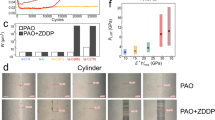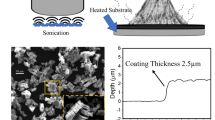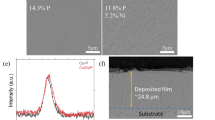Abstract
Moving mechanical interfaces are commonly lubricated and separated by a combination of fluid films and solid ‘tribofilms’, which together ensure easy slippage and long wear life1. The efficacy of the fluid film is governed by the viscosity of the base oil in the lubricant; the efficacy of the solid tribofilm, which is produced as a result of sliding contact between moving parts, relies upon the effectiveness of the lubricant’s anti-wear additive (typically zinc dialkyldithiophosphate)2. Minimizing friction and wear continues to be a challenge, and recent efforts have focused on enhancing the anti-friction and anti-wear properties of lubricants by incorporating inorganic nanoparticles and ionic liquids3,4. Here, we describe the in operando formation of carbon-based tribofilms via dissociative extraction from base-oil molecules on catalytically active, sliding nanometre-scale crystalline surfaces, enabling base oils to provide not only the fluid but also the solid tribofilm. We study nanocrystalline catalytic coatings composed of nitrides of either molybdenum or vanadium, containing either copper or nickel catalysts, respectively. Structurally, the resulting tribofilms are similar to diamond-like carbon5. Ball-on-disk tests at contact pressures of 1.3 gigapascals reveal that these tribofilms nearly eliminate wear, and provide lower friction than tribofilms formed with zinc dialkyldithiophosphate. Reactive and ab initio molecular-dynamics simulations show that the catalytic action of the coatings facilitates dehydrogenation of linear olefins in the lubricating oil and random scission of their carbon–carbon backbones; the products recombine to nucleate and grow a compact, amorphous lubricating tribofilm.
This is a preview of subscription content, access via your institution
Access options
Subscribe to this journal
Receive 51 print issues and online access
$199.00 per year
only $3.90 per issue
Buy this article
- Purchase on Springer Link
- Instant access to full article PDF
Prices may be subject to local taxes which are calculated during checkout





Similar content being viewed by others
References
Bowden, F. P., Gregory, J. N. & Tabor, D. Lubrication of metal surfaces by fatty acids. Nature 156, 97–101 (1945)
Spikes, H. The history and mechanisms of ZDDP. Tribol. Lett. 17, 469–489 (2004)
Tenne, R. Recent advances in the research of inorganic nanotubes and fullerene-like nanoparticles. Front. Phys. 9, 370–377 (2014)
Qu, J. et al. Synergistic effects between phosphonium-alkylphosphate ionic liquids and zinc dialkyldithiophosphate (ZDDP) as lubricant additives. Adv. Mater. 27, 4767–4774 (2015)
Erdemir, A. & Donnet, C. Tribology of diamond-like carbon films: recent progress and future prospects. J. Phys. D 39, R311–R327 (2006)
World Energy Council Global Transport Scenarios 2050 (World Energy Council, 2012)
Chu, S. & Majumdar, A. Opportunities and challenges for a sustainable energy future. Nature 488, 294–303 (2012)
Holmberg, K., Andersson, P. & Erdemir, A. Global energy consumption due to friction in passenger cars. Tribol. Int. 47, 221–234 (2012)
Tung, S. C. & McMillan, M. L. Automotive tribology overview of current advances and challenges for the future. Tribol. Int. 37, 517–536 (2004)
Spikes, H. Low- and zero-sulphated ash, phosphorus and sulphur anti-wear additives for engine oils. Lubr. Sci. 20, 103–136 (2008)
Cha, S. C. & Erdemir, A. Coating Technology for Vehicle Applications (Springer International Publishing, 2015)
Ferrari, A. & Robertson, J. Resonant Raman spectroscopy of disordered, amorphous, and diamondlike carbon. Phys. Rev. B 64, 075414 (2001)
Lim, S. C. & Ashby, M. F. Wear-mechanism maps. Acta Metall. 35, 1–24 (1987)
Kroto, H. W. Carbon onions introduce new flavour to fullerene studies. Nature 359, 670–671 (1992)
Gosvami, N. N. et al. Mechanisms of antiwear tribofilm growth revealed in situ by single-asperity sliding contacts. Science 348, 102–106 (2015)
Bowden, F. P. & Ridler, K. E. W. Physical properties of surfaces. III. The surface temperature of sliding metals the temperature of lubricated surfaces. Proc. R. Soc. A 154, 640–656 (1936)
Alpas, T., Hu, H. & Zhang, J. Plastic deformation and damage accumulation below the worn surfaces. Wear 162–164, 188–195 (1993)
Johnson, K. L. Contact mechanics and the wear of metals. Wear 190, 162–170 (1995)
David, D. J. & Misra, A. Relating Materials Properties to Structure with MATPROP Software: Handbook and Software for Polymer Calculations and Materials Properties (CRC Press, 2001)
Huheey, J. E., Keiter, E. A. & Keiter, R. L. Inorganic Chemistry: Principles of Structure and Reactivity (HarperCollins, 1993)
Sattler, J. J. H. B., Ruiz-Martinez, J., Santillan-Jimenez, E. & Weckhuysen, B. M. Catalytic dehydrogenation of light alkanes on metals and metal oxides. Chem. Rev. 114, 10613–10653 (2014)
Kang, D. B. & Anderson, A. B. Theoretical interpretation of the cyclohexane → benzene reaction on the Pt(III) surface. J. Am. Chem. Soc. 107, 7858–7861 (1985)
Ceamanos, J., Mastral, J., Millera, A. & Aldea, M. Kinetics of pyrolysis of high density polyethylene. Comparison of isothermal and dynamic experiments. J. Anal. Appl. Pyrolysis 65, 93–110 (2002)
Liao, Y. et al. Graphitic tribological layers in metal-on-metal hip replacements. Science 334, 1687–1690 (2011)
Mitchell, D. R. G. DiffTools: electron diffraction software tools for DigitalMicrograph. Microsc. Res. Tech. 71, 588–593 (2008)
Kazmanli, M. K., Ürgen, M. & Cakir, F. Effect of nitrogen pressure, bias voltage and substrate temperature on the phase structure of Mo-N coatings produced by cathodic arc PVD. Surf. Coat. Tech. 167, 77–82 (2003)
Oliver, W. C. & Pharr, G. M. An improved technique for determining hardness and elastic modulus using load and displacement sensing indentation experiments. J. Mater. Res. 7, 1564–1583 (1992)
Hsu, W. K. et al. Electrolytic formation of carbon nanostructures. Chem. Phys. Lett. 262, 161–166 (1996)
Qiao, Z., Li, J., Zhao, N., Shi, C. & Nash, P. Graphitization and microstructure transformation of nanodiamond to onion-like carbon. Scr. Mater. 54, 225–229 (2006)
Acknowledgements
Work at Argonne National Laboratory was supported by the US Department of Energy (DOE), Office of Energy Efficiency and Renewable Energy, Vehicle Technologies and Advanced Manufacturing Offices under contract DE-AC02-06CH11357. Use of the Center for Nanoscale Materials was supported by the US Department of Energy, Office of Science, Office of Basic Energy Sciences, under contract DE-AC02-06CH11357. This research also used resources of the Argonne Leadership Computing Facility at Argonne National Laboratory, which is supported by the Office of Science of the US Department of Energy under contract DE-AC02-06CH11357. This research used resources of the National Energy Research Scientific Computing Center, a DOE Office of Science User Facility supported by the Office of Science of the US Department of Energy under contract DE-AC02-05CH11231. XPS and TOF-SIMS measurements were carried out in the Frederick Seitz Materials Research Laboratory Central Research Facilities, University of Illinois. We thank R. Haasch for support with the XPS measurements and T. Spila for support with the TOF-SIMS measurements. We thank D. Gosztola for help with the Raman measurements at the Center of Nanoscale Materials, Argonne National Laboratory. We also thank S. Rodil, O. Depablos and R. Mirabal for help with the GIXRD measurements at Instituto de Investigaciones en Materiales, Universidad Nacional Autónoma de México. We thank E. A. Bardasz of Zual Associate in Lubrication for helpful discussions, and W. Connacher and M. McKinnon for their help in setting up the experiments.
Author information
Authors and Affiliations
Contributions
A.E. conceived the idea and directed the research project. O.L.E. is the co-principal investigator and, together with G.R., produced and optimized the nanocomposite coatings. G.R. carried out the XRD, XPS, nano-indentation and Raman measurements and analysis of the data resulting from those techniques. G.R. and O.L.E. carried out the tribological experiments. G.R., A.E. and O.L.E. analysed the data obtained during the tribological characterization. Y.L. carried out the HRTEM and FIB preparation and imaging as well as the analysis of the EELS data. G.R. performed the phase analyses of HRTEM images and diffraction patterns. S.K.R.S. guided the simulation effort. B.N. performed all the first-principles calculations and reactive molecular-dynamics simulations. B.N., G.K. and S.K.R.S. performed all the related data analysis. A.E. composed the manuscript with input from all authors.
Corresponding author
Ethics declarations
Competing interests
The authors declare no competing financial interests.
Extended data figures and tables
Extended Data Figure 1 HRTEM analysis of the MoNx–Cu nanocomposite coating.
Measurements of d spacing were performed using the DiffTools suite in DigitalMicrograph software25. a, Diffraction pattern, showing the presence of two phases of MoNx that have been reported in the Inorganic Crystal Structure Database (ICSD; http://icsd.fiz-karlsruhe.de/): hexagonal δ-MoN (ICSD accession number 99452) and cubic δ′-MoN (ICSD accession number 159439). b, Measurements of the d spacing taken directly from the HRTEM image show the presence of nanocrystals of copper (ICSD 64699) in the film. c, δ-MoN found in the nanocomposite coating. d, γ-Mo2N in the coating. e, Copper nanocrystal close to the surface. The numbers in parentheses in the figure are the Miller indices of crystallographic planes.
Extended Data Figure 2 X-ray diffraction patterns of the MoNx–Cu coating.
These spectra show the presence of copper, the molybdenum bonding layer and three different phases of MoNx. The possible MoN phases that can be produced by physical vapour deposition have been well studied26, but identifying such phases by XRD is difficult because the diffraction peaks can overlap. Here, grazing incidence XRD could not recognize the molybdenum bonding layer (between substrate and coating) that is identified with the peak at 40.5° in the Bragg–Brentano measurement, and which corresponds to the (110) plane of molybdenum (ICSD accession number 52267). The presence of the hexagonal δ-MoN, cubic γ-Mo2N and cubic δ′-MoN in the MoNx−Cu nanocomposite coating was confirmed using the relevant peaks. The lattice parameters were calculated on the basis of the d spacing of the peaks. The peaks located at 35.7°, 48.24° and 64.14° correspond to the (200), (202) and (220) planes, respectively, of δ-MoN (ICSD accession number 99452); lattice parameters are a = 5.8035 Å and c = 5.7006 Å. The peak at 42.67° is well associated with the (200) plane of γ-Mo2N (ICSD accession number 158843); this peak is generally the one used to identify the presence of this phase26; the lattice parameter is a = 4.2345 Å. The cubic δ′-MoN (ICSD accession number 159439) was found via the low intensity peak at 60.11°; the lattice parameter is a = 4.35 Å. Copper is more evident on the grazing incidence XRD pattern (owing to the greater surface sensitivity compared with the Bragg–Brentano method and the possibility of observing planes that are different to those that are perpendicular to the surface). The peaks located at 43.68°, 50.88° and 74.82° are associated exclusively with the (111), (200) and (220) planes, respectively, of copper (ICSD accession number 64699) (a = 3.5864 Å).
Extended Data Figure 3 X-ray photoelectron spectroscopy of the MoNx–Cu coating.
a, Survey spectrum showing the presence of copper, molybdenum, nitrogen and oxygen in the film. The composition was calculated on the basis of the high-resolution peaks of the molybdenum 3d (doublet), oxygen 1s, nitrogen 1s and copper 2p3/2 orbitals. Intensity is in counts per second. b, High-resolution spectra showing the peaks corresponding to the molybdenum 3p3/2 and nitrogen 1s orbitals. c, High-resolution spectrum of the molybdenum 3d orbital. d, High-resolution spectrum showing the copper 2p3/2 orbital.
Extended Data Figure 4 Nanoindentation analyses of the MoNx–Cu coating.
a, Loading/unloading curves for the measurements, using loads of between 500 μN and 12,000 μN. The ‘depth’ on the x-axis refers to the penetration depth of the diamond indentation tip. Different loads were used to evaluate the hardness (H) and elastic modulus (Er) as a function of the contact depth (hc), in order to avoid any influence of the substrate’s mechanical properties. The Oliver–Pharr method27 was used to calculate the hardness and the elastic modulus of the coating. b, Hardness as a function of penetration. The hardness did not decrease with penetration, and was 19.6 ± 1.4 GPa. c, The elastic modulus of the coating was 234.7 ± 11.4 GPa across a range of indentations.
Extended Data Figure 5 TOF-SIMS spectra and mapping of the contact region.
See Supplementary Methods for experimental details. a, Spectrum of material from inside the contact spot (denoted with a circle). b, Spectrum of material from outside the contact spot (denoted with a circle). c, Spectrum after subtraction of the spectra in a and b, verifying the presence of carbon and other hydrocarbon fractions on the contact spot (subtraction has been done after normalization of each spectrum according to total ion counts). d, Two-dimensional TOF-SIMS images from the contact spot and surrounding regions, confirming the presence of carbon and hydrocarbon fractions in the contact spot. The strong carbonaceous signals in the far outside section of the perimeter are due to the carbon-rich debris layers shown in Figs 2b and 4a.
Extended Data Figure 6 Wear volumes, calculated using three-dimensional optical profilometry.
a, Three-dimensional representation of the volume loss of three steel balls (one coated with MoNx–Cu and two uncoated, in different oils) on the basis of flattening of the spherical caps of the steel balls. There is very little wear, with only a few scratches, on the ball coated with MoNx–Cu and tested in PAO 10. b, Wear volume calculations, based on the profilometry in a, and compared with geometrical calculations based on the wear scar diameter. The wear volumes calculated using the two techniques are comparable, except in the case of MoNx–Cu, where the diameter represents only the polished Hertzian contact area. 7.35E−15 is 7.35 × 10−15, and so on.
Extended Data Figure 7 Wear produced on the flat surface of the disk rubbing against the balls.
The optical micrographs at the top showing the physical condition and difference in wear track size in the three tests. The line scans and three-dimensional images below show the extent of wear damage more clearly. There is unmeasurable wear for the MoNx–Cu-coated flat surface. The steel surface tested in PAO 10 shows the highest wear loss, with a wider wear track and deep scratches; the flat surface tested in 5W30 oil shows a much smaller and narrower wear track.
Extended Data Figure 8 Detailed analysis of HRTEM images of the debris layer of MoNx–Cu.
a, HRTEM image showing nanocrystals of δ′-MoN and γ-Mo2N embedded in an amorphous carbon matrix. There were also onion-like carbons in many of the regions examined. The d-orbital spacing of 0.341 nm is a typical value for this form of carbon structure28,29. b, HRTEM image showing the amorphous matrix with one crystalline domain (yellow box), which corresponds to δ-MoN.
Extended Data Figure 9 EDS of the debris layer of MoNx–Cu tested in PAO 10.
The spectrum shows the presence of molybdenum on the tribofilm. Copper cannot be quantified using this method owing the background from the TEM column. On the left is a TEM image showing the area of interest from which the spectrum was generated.
Supplementary information
Supplementary Information
This file contains Supplementary Methods, Supplementary Text, Supplementary Figures 1- 9 and Supplementary References – see contents page for details. (PDF 2506 kb)
Atomistic evolution of a representative olefin molecule between two sliding transition metal surfaces as shown by our reactive molecular dynamics (MD) simulations.
Under the catalytic activity of the transition metal surfaces, the linear olefin chains dehydrogenate, and break down into shorter hydrocarbon molecules. (MPG 12876 kb)
Temporal evolution of linear olefin molecules between sliding metal surfaces that do not form stable carbides as shown by our reactive MD simulations at 900-1,000 K.
Here as a typical example of non-carbide forming transition metal, we shown Cu (111). Under the sliding action, the linear olefins degenerate via dehydrogenation (dissociation of C-H bonds), and random scission of backbone C-C bonds resulting in short hydrocarbons fragments. The free H gets adsorbed to the metal near the metal-olefin interface; subsequently they diffuse into the bulk of the metal or form H2 molecules. (MP4 23938 kb)
Temporal evolution of linear olefin molecules between sliding metal surfaces that form stable carbides as shown by our reactive MD simulations at 900-1,000 K.
Here, we show V (001) surfaces wherein, aggressive carbide formation takes place. The formation of such thermodynamically preferred metal carbides precludes formation of DLC-like tribofilms. (MPG 1966 kb)
Temporal evolution of linear olefin molecules between sliding Mo (001) surfaces during reactive MD simulations.
Although Mo is known to form stable carbide, and shows degradation of olefins similar to Cu and V, the catalytic activity at 1,000 K is much lower, resulting in sluggish kinetics. (MPG 12800 kb)
Evolution of a 1-pentene molecule on Cu(111) during AIMD simulation at 1,000 K.
Evolution of a 1-pentene molecule on Cu(111) during AIMD simulation at 1,000 K. (MOV 19246 kb)
Evolution of a 1-pentene molecule on Mo (100) during AIMD simulation at 1,000 K.
Evolution of a 1-pentene molecule on Mo (100) during AIMD simulation at 1,000 K. (MOV 22498 kb)
Evolution of a 1-pentene molecule on V (100) during AIMD simulation at 1,000 K.
Evolution of a 1-pentene molecule on V (100) during AIMD simulation at 1,000 K. (MPG 23596 kb)
Evolution of a1-pentene molecule on MoN (100) during AIMD simulation at 1,000 K.
Evolution of a1-pentene molecule on MoN (100) during AIMD simulation at 1,000 K. (MOV 5988 kb)
Rights and permissions
About this article
Cite this article
Erdemir, A., Ramirez, G., Eryilmaz, O. et al. Carbon-based tribofilms from lubricating oils. Nature 536, 67–71 (2016). https://doi.org/10.1038/nature18948
Received:
Accepted:
Published:
Issue Date:
DOI: https://doi.org/10.1038/nature18948
Comments
By submitting a comment you agree to abide by our Terms and Community Guidelines. If you find something abusive or that does not comply with our terms or guidelines please flag it as inappropriate.



